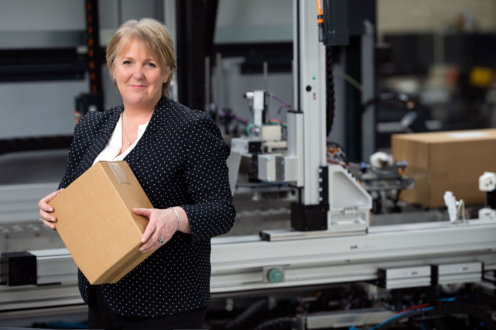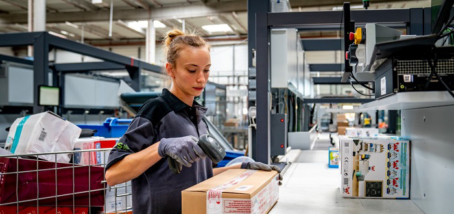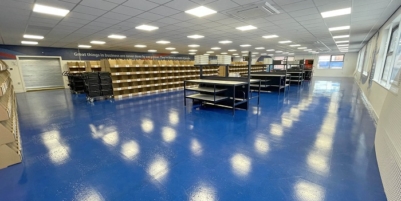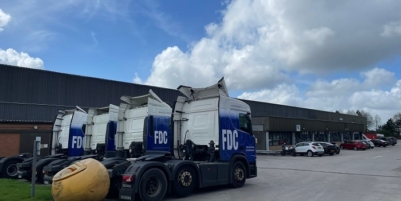-
Nutrivend selects Forterro’s Orderwise to support online expansion and streamline operations - April 11, 2025
-
ARROWXL LAUNCHES AMBITIOUS ZERO WASTE ROADMAP - April 8, 2025
-
THE BCMPA’S NEW CAMPAIGN DRIVES OUTSOURCING SUCCESS IN Q1 - April 7, 2025
-
BLACKOUT TECHNOLOGIES TARGETS TELEMATICS-INTEGRATED MOBILE DEVICE BLOCKING TO COMBAT SMARTPHONE DISTRACTION - April 1, 2025
-
OpenADR Alliance announces first OpenADR 3.0 certified products with EVoke Systems, E.ON Energy and Universal Devices - March 25, 2025
-
Growing fulfilment and contract packer appoints new Managing Director - March 25, 2025
-
When is it time to invest in a WMS? Understanding the key trigger points - March 25, 2025
-
eCapital helps Vantage Recruitment on its journey to financial success - March 24, 2025
-
Hugo Beck Celebrates 70 Years of Packaging Innovation with Open House Events - March 20, 2025
-
PROLOG FULFILMENT SUPPORTS LUNA DAILY’S COMMITMENT TO BETTER BODY CARE FOR ALL WOMEN - March 19, 2025
The pandemic has been a catalyst for change, way beyond our expectations. Ecommerce has been propelled to new heights, with online order volumes swamping conventional fulfilment centres. Now, as a second wave sweeps the country, are businesses ready for the predicted mega-peaks of a Covid Christmas? By Jo Bradley, Business Development Manager for packaging solutions at Quadient.

The Centre for Retail Research expects ecommerce sales in Western Europe (UK, Germany, France, Netherlands, Italy and Spain) to reach £294Bn in 2020, against a pre-Covid forecast of £249Bn. This represents a growth of +31% in a single year, giving online a 16.2% share of total retail sales in 2020.
Indications are that ecommerce peaks this Christmas will be even more extreme than usual. Research from Klarna and Retail Economics has found that 71% of British consumers are reluctant to shop in store in the lead up to Christmas, with 56% saying they expect to do more online shopping this year.
So, how are online retailers going to cope with this sudden and protracted shift in demand for goods purchased over the net?
Leading into the Christmas period, most ecommerce operations take on additional staff to match demand, but a shortage of available labour, exacerbated by Brexit and a diminishing pool of migrant workers – coupled with the constraints imposed by social distancing requirements – has created a ‘perfect storm’ for ecommerce businesses.
Many retailers with a busy online channel will need to ask themselves the question: Is a conventional, heavily manual approach to preparing orders for dispatch still fit for purpose?
Fulfilling an ecommerce order has always been thought of as an inherently labour intensive activity, involving large teams of pickers and packers. But in the packing area advanced fit-to-size automated packaging technology is transforming operational performance, overcoming many of the obstacles presented by the Covid crisis and providing businesses with significant gains on sustainability, cost reduction, and customer experience.
Here are five key points to consider when adopting automation in the packaging area:
1. Increase capacity – be ‘peak ready’
The traditional, manual, approach to packing has been significantly challenged by three key factors.
Firstly, following Brexit, available labour resources are no longer as easy to access in many areas of the country. Secondly, the National Living Wage, applicable to all employees over 25 years old, has risen to £8.72. And thirdly, with the outbreak of COVID-19, social distancing requirements within the warehouse present a major headache for organisations.
If peak volumes are set to rise then packaging performance will need to be radically improved. Bringing in large teams of people at peak is simply no longer a viable option.
Greater use of automation in the packing area will help. But simple, size-constrained machines using only one-size of box does not cater for the wide variety of products and order sizes experienced by most online retailers. If demand for smaller items to be packed exceeds the capacity of the relevant machine, the shipper has no option but to move up a box size, or two, leading to wasteful use of materials and extra shipping costs. A more flexible approach is needed.
Using fit-to-size auto-boxing technology, such as Quadient’s CVP Everest, one machine can flexibly handle a wide variety of order sizes, creating a perfect-size box for each order at a rate of up to 1,100 packages per hour. Operating consistently and reliably at these speeds, such a machine has the potential to replace between 20-30 packing desks, offering a rapid ROI.
2. Build in sustainability
Oversized packaging is wasteful. More cardboard is used, void-fill is necessary and fewer packages are carried per trailer, leading to excessive CO2 emissions and higher fuel, material and carriage costs. Making each individual package to the exact size needed better protects the item in transit – without the need for void fill – minimises cardboard usage, saves resources and reduces shipping costs.
Using advanced 3D scanning technology, Quadient’s CVP Everest perfect-size packaging system scans and measures an item, or group of items, to be packed and calculates the ‘best fit’ box shape and size. Material for the box and lid is cut and creased to size, erected around the item(s) and the lid glue-sealed – which is faster and more recyclable than using tape. Parcels are then automatically weighted, labelled and away.
By consistently making each box to the exact dimensions needed to hold the item(s) firmly, goods are better protected and package volumes can be reduced by up to 50%, cutting cardboard usage by 20% and eliminating the need for void fill. The savings on materials are significant in themselves.
3. Reduce shipping costs
Shipping air serves no purpose it simply increases cost unnecessarily and negatively impacts the environment. Oversized packages contribute directly to more vehicles on the road, pollution, congestion and greater shipping expenses. The larger the box, the fewer can fit into a trailer.
Until fairly recently carriage charges for domestic deliveries were based on a parcel charge with maximum weight and dimensions per parcel, so there was on incentive to use a smaller box as fresh air moved for free. That is changing. Many of the larger carriers and couriers have moved to a dual system whereby carriage is charged at a rate based on actual weight or ‘volumetric’ or ‘dimensional’ weight, whichever is the greater. Consequently, size really does matter.
Tailor-making a perfectly sized box, specifically for each order is now, not only possible, but also readily available at speeds of up to 1,100 packages per hour. And Quadient technology, in the form of the CVP Everest or the CVP Impack, makes it entirely feasible to maximise the cube of a trailer by reducing package volumes by up to 50%. One major retailer now gets 60 boxes on a pallet as opposed to 30, saving the business a trailer a day – a significant cost saving over a year.
4. Increase operational efficiency
Automation in the form of fit-to-size packing systems can remove the need for between 20-30 packing desks, freeing up valuable and increasingly scarce labour resources for other more value adding duties. In addition, the capacity to produce high volumes of perfectly-sized packages at speed can reduce the stress of having to find additional labour at peak – a process that often requires early planning and exposure to risk. Fit-to-size automation enables you to be peak ready and fully equipped for future growth.
5. Enhance the customer experience
Consumers are increasingly disgruntled by wasteful packaging – oversized boxes filled with expanded polystyrene, bubble wrap and other forms of void fill. This is reflected in a ‘Which?’ survey where 48% of customers agree that “excessive packaging is one of the most annoying things about online shopping”. Survey evidence also suggests that customers feel more positively about brands that are trying to reduce unnecessary packaging.
How a package is received is all part of the brand experience. Perfectly sized packaging protects items in transit better, leading to fewer breakages, and less packaging for the customer to dispose of in the recycling bin. The ‘unboxing experience’ is all about presentation – it can play a significant part in a customer’s perception of the product and a positive unboxing experience is more likely to lead to further orders.
Fit-to-size packaging technology is transforming ecommerce packing performance. For more information go to www.packagingbyquadient.com
Jo Bradley is Business Development Manager for packaging solutions at Quadient

































